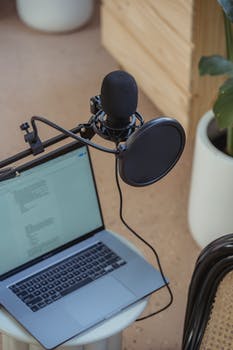Hi everyone,
Activity 3: Record Audio
I chose to start my audio recording using 44,100 Hz. I also started my audio recording with 20 seconds of silence to assess whether noise reduction was required. I did not find any large amounts of background noise so I simply edited out the first 20 seconds of silence. My short audio recording is simply a brief personal introduction. I was happy to discover that Audacity was the chosen audio-editing software for this activity as I have prior experience working within this specific program. I was able to effectively follow the “Record” tutorial (Audacity, 2019) and I was able to set my recording meter without any distracting feedback or mic noise. I am excited to learn more about recording audio for the purposes of podcast and educational lessons.
Please listen to my brief recording below…
Activity 4: Edit Audio
I chose to edit my Open Yale Course resource from Activity 2. I used Audacity to trim all audio outside of my chosen 10:00-14:44 selection of audio. I first had to download the original 45:04 audio recording from Tamar Gendler. I then imported the audio recording into Audacity. Once Audacity finished importing my resource I then chose to use the Selection Tool (F1) which allowed me to highlight from 00:00 to 10:00 and from 14:45 to 45:04. Once I highlighted these two sections using the Selection Tool (F1), I then clicked Trim Audio Outside Selection (CTRL+T). Clicking CTRL+T deleted my two chosen selections which left me with my trimmed audio recording of 4:44. I also chose to use the Normalize effect which reduced peak amplitude to -1.0 dB.
Please listen to the edited Open Yale Course resource below:
Activity 5: Use Audio Filters
I chose to use noise reduction to filter out some of the background noise from the “Oral Book Reports” (Unidentified & Meyers, 1967/1968) audio clip. I used my keyboard to Select All (CTRL+A) and then I selected Noise Reduction in the Effects list. Within the Noise Reduction settings I chose 10DB noise reduction with 6.00 sensitivity as I personally felt that anything above 10-12 DB noise reduction reduced the overall clarity of the narrator’s voice without major benefit to the reduction of background noise. Overall, I felt that the Noise Reduction effect worked effectively to reduce the large degree of background static in the original recording.
Please listen to the original “Oral Book Reports” (Unidentified & Meyers, 1967/1968) audio clip below:
Now, compare the original “Oral Book Reports” (Unidentified & Meyers, 1967/1968) audio clip with my noise-reduced edit below:
Activity 6: Combine Audio Files
I created an audio file on the topic of art within human psychology. I chose to add a basic piano music file from Last.fm to work with my narration file. Please listen to the embedded audio file below.
I chose to follow the “Mixing a Narration with Background Music” (Audacity, 2019) tutorial throughout this activity.
The main difficulty I discovered was that Step 4 of the Audacity tutorial only provides guidance pertaining to overlapping the primary narration sections with the background music. However, for the purposes of this activity, I chose not to overlap my background music throughout the entirety of my narration. As a consequence, I had to learn how to cut my music track into four smaller sections in order to use them as intermissions before, between, and after my narration sections.
I also chose to record my narration section in one attempt as I wanted to challenge myself to edit out coughing, audio-peaks, and stuttering. My original recording was close to 10-minute in duration and was disjointed prior to my editing.
Throughout this activity I had to use the cut tool, the selection tool, and the envelope tool in order to create fade in and fade out effects. I also needed to use the Amplify and the Normalize effects in order to reduce peaking sounds which were quite loud in my original recording (I could use a new mic). I would imagine using my audio file on Carl Jung’s (1933) Modern Man in Search of a Soul as a brief podcast or as a supplementary material to a psychology unit.
Best,
Carson 🙂
References
Audacity. (2019, November 15). Record. https://manual.audacityteam.org/man/record.html
Audacity. (2019, November 15). Tutorial: Mixing a narration with background music. https://manual.audacityteam.org/man/tutorial_mixing_a_narration_with_background_music.html
Gendler, T. (2012, March 27). 3. parts of the soul I : Tamar Gendler. Internet Archive. Retrieved February 28, 2022, from https://archive.org/details/podcast_philosophy-science-huma_3-parts-soul-i_1000112264831
Jung, C. G. (1933). Modern Man in Search of a Soul. Harcourt.
Unidentified (Speaker), & Meyers, M. (Collector). (1967/1968). Oral book reports with 18 year old white female, New Haven, Connecticut [Speech audio recording]. Library of Congress. https://www.loc.gov/item/afccal000204/



Hi Carson,
You’ve created some good audio here. I agree that noise reduction is an effect where you need to weigh the amount of filtration with the distortion that may follow. This equation leans more in your favour when you have a longer background noise clip to sample and the more the noise is a consistent pattern. This means that you can suppress electronic interference more than a vacuum cleaner in the background, and you can suppress a vacuum cleaner in the background more than a flock of crows.
I like your combined audio file. I think I would boost your voice a little earlier.
Thanks for your kind words and suggestions Keith. Finding that sweet balance between noise reduction/amplification can be a tough go sometimes. I appreciate that you liked my audio file and I will look into how to best boost my voice.
Carson